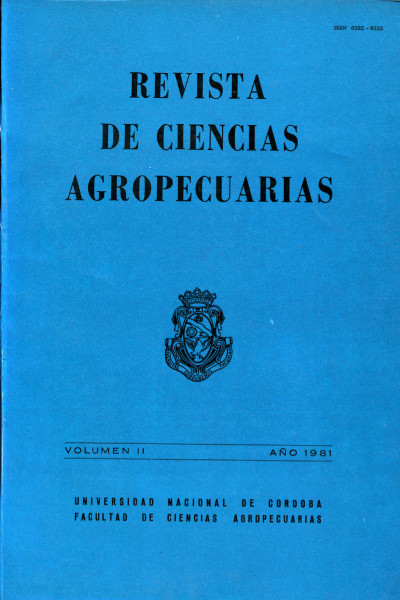The experiment was conducted in order to study the effect of CCC / (2- chloroethyl) trimethyl-ammonium chloride/ and of water stress on the growth of soybean plants /Glycine max (L.) Merril/ cultivar Halesoy 71
Main Article Content
Abstract
Downloads
Article Details
References
BOYER, J. S.: 1970. Leaf enlargement and metabolic rates in corn. soybean and sunflower at various leaf water potentials. Pl. Physiol. 46: 233-235.
CATHEY, H. M.: 1964. Physiology of growth retarding chemicals. Ann. Bev. Pl. Physiol. 15: 271-302.
CHAILAKHYAN, M. Kh. y ARUTYUNYAN, R Sh. 1968. Effect of the retardant CCC on growth, tuber formation and rhizosphere microorganisms in legumes. Biol. Zh. Arm. 21 (4): 3-11. Resumen en Biol. Abstr. 51 (20).
EL DAMATY, H.; KUHN, H. y H. LINSER: 1964. A preliminary investigation on increasing salt tolerance of plants by application of (2-ehloroe tihyl) - trimethylammonium chloride. Agrochim. 8 (2): 129-138.
GRUZDEV, L. G. y NENAIDENKO, G. N.: 1974. Quality of the yeld of winter wheat and rye treated whith ch orocholine chloride and 2, 4-D.
H. Kh. Biol. 9 (3) : 359-364. Resumen en Biol. Abstr. 59 (11) : 6262.
HALEVY, A. H. y KESSLER, B. 1963. Increased tolerance of bean plants to soil drought by means of growth-retarding substances. Nature. 187: 310-311.
HUMPHRIES, E. C.: 1963. Effects of (2 chloro-ethyl) trimethyl ammonum chloride on plant growth, leaf area, and net assimilation rate. Ann. of Bot. , NS. 27 (107) : 517- 532.
KOSHUCHOVA, S. y MUENNICH, H.: 1974. The influence of CCC on the growth of plants: II. Relation between the growth of cells and leaves of wheat seed'ings. Wiss Z. Humboldt. Univ. Berl. Math. Naturwiss Reihe. 23 (6): 659-662. Resumen en Biol. Abstr. 60 (12) 7368.
LINSER, H. V KHCHN, H.: 1962. Fertilizers for the control of lodging on the basis of gibbereilic acid antagonist of the CCC group (Chlorocholine chloride). Bodenkunde. 96 (141) : 231-274.. Citado en Cyanarrud International. Información técnica. 1966.
LOVET, J. V. y CAMPBELL, D. A.: 1973. Effect of CCC and moisture stress on sunflower. Exp. Agric. 9 (4): 329-337.
MARTH, P. C.: 1965. Increased frost resistance by aplication of plan, growth-retardant chemicals. J. Agric. Food Chem. 13(4): 331-333.
MARTH, P. C. y FRANK, J. R.: 1961. Increasing tolerance of soybean plants to some soluble salts trough aplication of plant growth-retardant chemicals, J. Agrie. Food Chem. 9 (5) : 360-361.
MICHNIEWICZ, M. y KENTZER, T.: 1965. The increase of frost resistance of tomato plants through application of 2-óhloroethyl trimethylammonium chloride (CCC). Esperientia 21 (4): 230-231.
MORANDI, E. N.: 1976. Ensayo con diversos materiales para reducir la evaporación del agua del suelo en macetas. Informe Dactilograf. Cons. de Investig. U.N.R. 7 pp.
PIKUSH, G. R.: 1974. Effect of ch'orocholine chloride on formation of frost resistance in winter wheat. Fisiol. Biokhim. Kul't Rast. 6 (1) : 54-60. Resumen en Biol. Abstr. 59 (6) : 3626.
PINTHUS, M. J. y HALEVY, A. H.: 1965. Prevention of lodging and. increase in yield of wheat treated with CCC (2- hlodoethyltrimethylammonium chloride). Israel Tour. Agric. Res. 15 (3): 159-161. Citado en Cyanamid International, Información técnica, 1966.
PLAUT, Z.; HALEVY, A. H. y SHMUELL, B., 1964. The effect of growthretarding chemical on growth and transpiration of bean plants grown under various irrigation regimes. Israel J. Agr. Res. 14 (4): 153-158.
ROBERTSON, G. A. y GREENWAY, H : 1973. Effects of CCC on drought resistances of Triticum aestivum L. and Zea Botany. 47: 260-66. Citado en Cathey, H. M. 1964. Physiology of Growth retarding chemicals, Ann. Rev. Pl. Phys'.ol. 15: 271302.
SACHS, R. M.; LANG, A.; BRETZ, C. F. y ROACH, J. 1960. Am. J. Botany. 47: 260-66. Citado en Cathey, H. M. 1964. Physiology of Growth Retarding Chemicals. Ann. Rev. Pl. Physiol. 15: 271-302.
TOLBERT, N. E.: 1960. (2-chloroethyl) trimethylammonium chloride and related compounds as plant growth substances. I. Chemical structure and bioassay. Jour. Biol. Chem. 235: 475-479.





